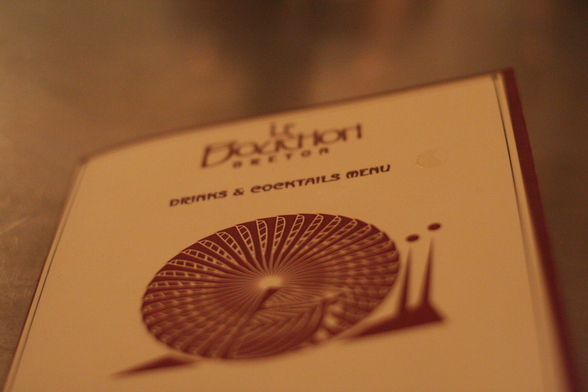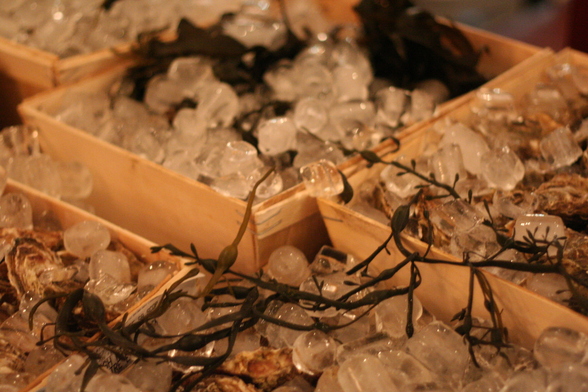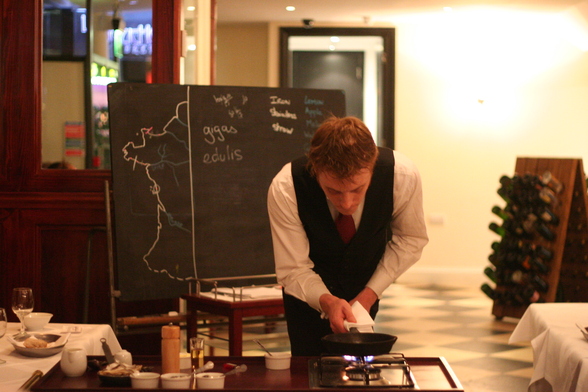Posted By Kerri

A few weeks ago, I was contacted by the PR company behind Le Bouchon Breton is Spitalfields and asked if I wanted to attend their latest oyster masterclass; we would be tasting a selection of 10 oysters from France, England, Scotland and the Channel Islands, all paired with a selection of Champagne and fine wine.
I like oysters but tend to stick to Whitstable native oysters, simply because it’s usually in Whitstable that I tend to eat them. I didn’t even know there were 10 varieties so clearly I needed to attend the class to enhance my understanding.

On arrival I was greeted with a glass of Champagne and a trolley full of oysters, I could see the 10 different types but it was difficult to tell the difference between them at this stage. Once I started to taste, it became clear that the complexities of flavour and texture varied hugely between the different varieties.

Before the tasting began, we were introduced to our ‘machine’, the implement we would be using to open our oysters throughout the evening and then take home with us. It was much like an ordinary oyster shucker but it had an extra lever that was used for cracking the shell of the oyster to facilitate easier opening. I felt a bit of a fraud using the ‘machine’ (it reminded me of those hinged, children’s chopsticks), but I was glad to have it since it did make the opening much easier and given that I’m somewhat accident prone, it probably saved me a trip to A&E.
There were about of us at the tasting, seated at tables in the restaurant arranged in a U shape with our oyster maestro Yoann Truwant in the middle demonstrating the shucking and explaining the difference between them. He also talked us through how oysters are grown, which are considered to be the best and how to eat them.
Grown – all oysters are farmed. This is important for the shape, the packaging and the transport. They are turned at least 150 times during their lifetime and generally live to be 2.5-3 years old (Pacific) or 6 years old (native). 85% of the oysters eaten in Europe are from Japan or Canada. The other 15% are the native. The native are twice the price of the Pacific oysters, due to their longer growing time.
The best oysters in the world are considered to be French Fin de Claire and the Special de Claire. Yoann didn’t go into much detail about why these were the best but they weren’t my favourite of those we tasted. Incredibly salty and strongly flavoured with an almost flabby texture, they didn’t come close to the native oysters I’m used to and that we tasted later on.
How to eat them? Not with the shallot vinegar that they’re so often served with. It’s best to dip bread into this in between tasting/eating as it will dilute the saltiness and help your palate to re-adjust to a normal, saline level. The first oysters we tried were accompanied by a glass of Champagne, a classic combination but not the best. The Champagne was slightly too acidic to let the full flavour of the oyster shine and the Muscadet we drank next worked much better. The Poilly Fume worked well too, especially with the sweeter, native oysters.
Aside from the native oysters from Au Pied D’Cheval and Loch Ryan that I liked the best, (due to their perfect balance between saltiness and sweetness, their long finish and the hint of Marmite/olive-like unami), I also really enjoyed the Jersey oysters. They had a very clean taste and a meaty texture with a full flavour and a more subtle hit of saltiness.

At the end of the session, Yoann demonstrated how to cook oysters and serve them with a cream and spinach sauce. At the same time, the chefs in the kitchen were busy replicating the dish for us to sample with a glass of Entres deux Mer. These were very good, the breadcrumbs adding a pleasing texture contrast to the silky, meaty oysters and hit of aniseed from the Pernod they were cooked in.

As the evening drew to a close, I spent some time talking to the other ‘students’ about what we had learnt and their reasons for attending. Many of them were local, loved the restaurant and were keen to come back again; some simply loved oysters and wanted to learn more and others mentioned that they were bored of eating out and wanted to experience something different.
It certainly was a different kind of dining experience: an interesting opportunity to learn more about the food you’re eating and be involved in a more sociable and interactive way of eating in a restaurant. I came away with a much better understanding of ‘bivalve molluscs’ and how to eat them which can only be a good thing.
Future classes will run on the following dates:
Friday 30 October 2009 from 6.30pm
Friday 27 November 2009 from 6.30pm
Friday 29 January 2010 from 6.30pm
Friday 26 February 2010 from 6.30pm
Friday 26 March 2010 from 6.30pm
Classes cost £60. To book, contact reservations at Le Bouchon Breton on 08000 191 704.
Le Bouchon Breton
8 Horner Square,
Old Spitalfields Market,
London
E1 6EW
You can see the full set of pictures here.
9 Comments to 'Oyster Masterclass'
Subscribe to comments with RSS or TrackBack to 'Oyster Masterclass'.
:: Trackbacks/Pingbacks ::
-
Pingback by Cheese Masterclass at Le Bouchon Breton | Dinner Diary - on November 1st, 2009 at 4:46 pm
Leave a Reply
You must be logged in to post a comment.

oooo I am very envious of your experience! I love oysters and I didn’t know there were so many varieties either. My only problem is often when I eat them I get struck down with food poisoning the next day. It has happened quite a few times now – one oyster and bang – ill in bed for a few days. It is a bit like Russian Roulette for me now. It isn’t fair! I really want to eat them but I’m rather timid. I may find the courage again soon…maybe I am simply allergic?! But it hasn’t happened everytime – the ones I ate in Oz were okay so…?! I don’t understand! xxx
.-= The Curious Cat´s last blog ..Blog Hijack =-.
PS Loving the shucking instrument too!
.-= The Curious Cat´s last blog ..Blog Hijack =-.
I am very jealous – I looooove oysters. I agree, the Whitstable ones are delicious though the best I’ve had were in Kinsale, in Ireland.
.-= Lizzie´s last blog ..Sweet Chilli Jam =-.
Lizzie, Kerri came and met me afterwards where I was in the pub with some friends and she mentioned the oysters and one of our friends actually commented that the best ones that he had tasted were somewhere in Ireland. He couldn’t remember exactly where though; I wonder if they were the same ones that you had.
Hey,
When I look at those comment, i’m thinking to get oysters from the bay of Galways… they are fantastic! but after all there are all so good!
yo
Oh my goodness – jealous or what?! I ADORE oysters. Best hangover cure going no matter how weird it sounds. I had absolutely no idea that you shouldn’t put the shallot vinegar on the oyster. I love doing that – what am I supposed to do now?!
.-= Helen´s last blog ..A (Long Overdue) London Sandwich Post =-.
I can’t stomach oysters when I’m hungover, Helen but I do remember you’ve said that before.
The shallot vinegar was a revelation to me too, I’m not sure what will happen next time I’m faced with a plate of oysters but the advice certainly made sense when I tried it.
hey,
the best would be to use the shallots vinegar in between oyster.
The next oyster class is full for the end of the month, so I had to open one on satuday night as well.
yo